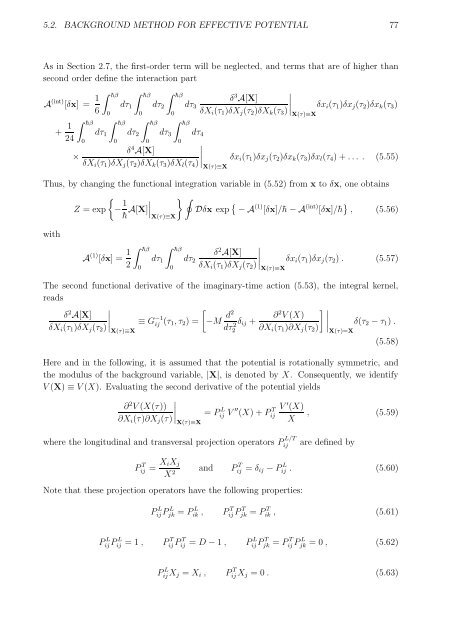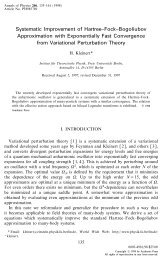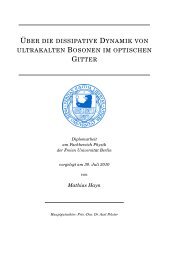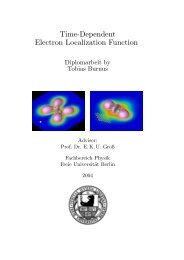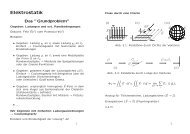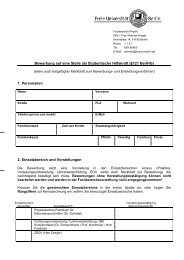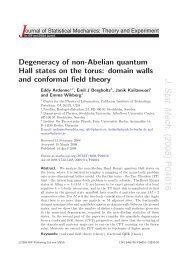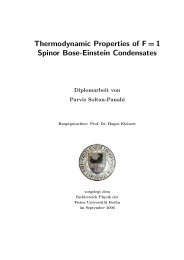Diploma thesis - Fachbereich Physik
Diploma thesis - Fachbereich Physik
Diploma thesis - Fachbereich Physik
You also want an ePaper? Increase the reach of your titles
YUMPU automatically turns print PDFs into web optimized ePapers that Google loves.
5.2. BACKGROUND METHOD FOR EFFECTIVE POTENTIAL 77<br />
As in Section 2.7, the first-order term will be neglected, and terms that are of higher than<br />
second order define the interaction part<br />
A (int) [δx] = 1 ∫ ¯hβ ∫ ¯hβ ∫ ¯hβ<br />
δ 3 A[X]<br />
dτ 1 dτ 2 dτ 3<br />
6 0 0 0 δX i (τ 1 )δX j (τ 2 )δX k (τ 3 ) ∣ δx i (τ 1 )δx j (τ 2 )δx k (τ 3 )<br />
X(τ)≡X<br />
+ 1 ∫ ¯hβ ∫ ¯hβ ∫ ¯hβ ∫ ¯hβ<br />
dτ 1 dτ 2 dτ 3 dτ 4<br />
24 0 0 0 0<br />
δ 4 A[X]<br />
×<br />
δX i (τ 1 )δX j (τ 2 )δX k (τ 3 )δX l (τ 4 ) ∣ δx i (τ 1 )δx j (τ 2 )δx k (τ 3 )δx l (τ 4 ) + . . . . (5.55)<br />
X(τ)≡X<br />
Thus, by changing the functional integration variable in (5.52) from x to δx, one obtains<br />
Z = exp<br />
{− 1¯h ∣ } ∮<br />
A[X]<br />
∣∣X(τ)≡X<br />
Dδx exp { − A (1) [δx]/¯h − A (int) [δx]/¯h } , (5.56)<br />
with<br />
A (1) [δx] = 1 2<br />
∫ ¯hβ<br />
0<br />
∫ ¯hβ<br />
dτ 1 dτ 2<br />
0<br />
δ 2 A[X]<br />
δX i (τ 1 )δX j (τ 2 ) ∣ δx i (τ 1 )δx j (τ 2 ) . (5.57)<br />
X(τ)≡X<br />
The second functional derivative of the imaginary-time action (5.53), the integral kernel,<br />
reads<br />
]∣<br />
δ 2 A[X]<br />
δX i (τ 1 )δX j (τ 2 ) ∣ ≡ G −1<br />
ij (τ 1, τ 2 ) =<br />
[−M d2 ∂ 2 V (X) ∣∣∣X(τ)=X<br />
δ ij +<br />
δ(τ 2 − τ 1 ) .<br />
X(τ)≡X<br />
∂X i (τ 1 )∂X j (τ 2 )<br />
dτ 2 2<br />
(5.58)<br />
Here and in the following, it is assumed that the potential is rotationally symmetric, and<br />
the modulus of the background variable, |X|, is denoted by X. Consequently, we identify<br />
V (X) ≡ V (X). Evaluating the second derivative of the potential yields<br />
∂ 2 V (X(τ))<br />
∂X i (τ)∂X j (τ) ∣ = Pij L V ′′ (X) + Pij<br />
T<br />
X(τ)≡X<br />
V ′ (X)<br />
X , (5.59)<br />
where the longitudinal and transversal projection operators P L/T<br />
ij<br />
are defined by<br />
P T<br />
ij = X iX j<br />
X 2 and P T<br />
ij = δ ij − P L<br />
ij . (5.60)<br />
Note that these projection operators have the following properties:<br />
P L<br />
ijP L jk = P L<br />
ik ,<br />
P T<br />
ijP T jk = P T<br />
ik , (5.61)<br />
P L<br />
ij P L<br />
ij = 1 ,<br />
P T<br />
ij P T<br />
ij = D − 1 ,<br />
P L<br />
ij P T jk = P T<br />
ij P L jk = 0 , (5.62)<br />
P L<br />
ij X j = X i ,<br />
P T<br />
ij X j = 0 . (5.63)


